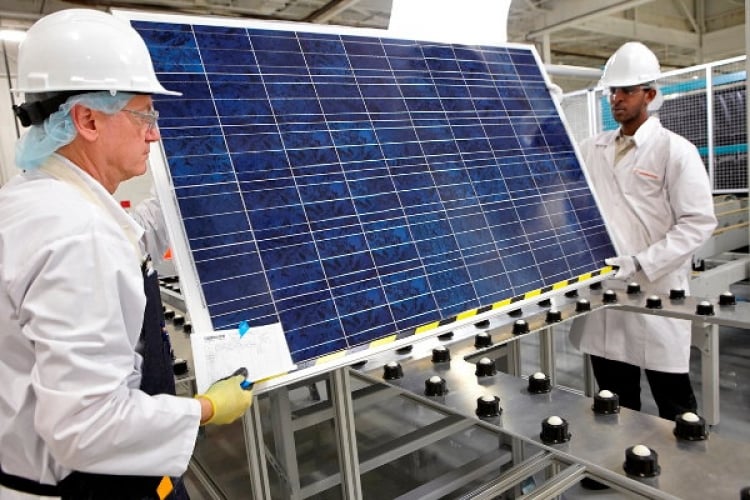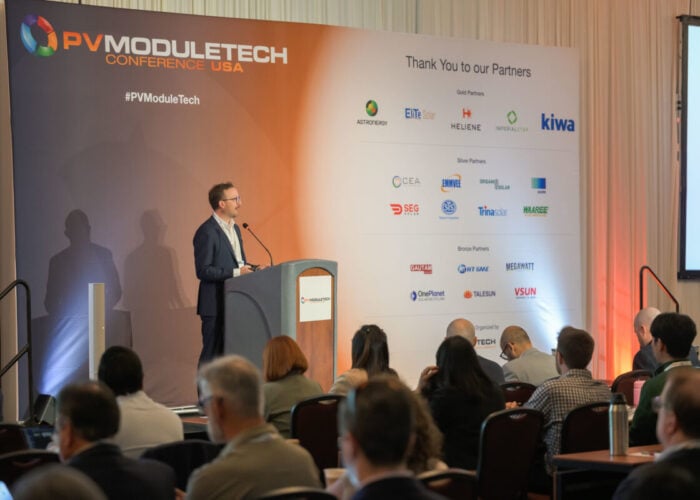
Canadian Solar has warned of solar cell overcapacity next year, slamming the breaks on its own cell manufacturing expansion plans while accelerating on its module assembly roadmap.
Reporting its Q3 2021 results yesterday, Canadian Solar chief executive Shawn Qu said the company’s manufacturing division was to respond to a projected overcapacity of solar cells next year, while Yan Zhuang, president at CSI Solar, would limit investment in certain areas of the manufacturing chain to “avoid falling into the overcapacity trap”.
Unlock unlimited access for 12 whole months of distinctive global analysis
Photovoltaics International is now included.
- Regular insight and analysis of the industry’s biggest developments
- In-depth interviews with the industry’s leading figures
- Unlimited digital access to the PV Tech Power journal catalogue
- Unlimited digital access to the Photovoltaics International journal catalogue
- Access to more than 1,000 technical papers
- Discounts on Solar Media’s portfolio of events, in-person and virtual
In an updated capacity expansion plan provided yesterday, Canadian Solar said it expected to finish the year with around 13.9GW of solar cell manufacturing capacity, up from the 13.3GW of cell capacity it finished Q3 on. However this figure is now not expected to rise at all next year.
Likewise, CSI expects to finish the year with 11.5GW of solar wafering capacity, a figure it also currently expects to finish 2022 on.
The division had, however, ramped up its module assembly capacity plans and expected to add nearly 10GW of module assembly between the end of Q3 2021 and the end of 2022, taking its overall module assembly capacity to 32GW by the end of next year. Just over 8GW of module assembly capacity is expected to be added next year.
Meanwhile, CSI also expects to almost double is solar ingot capacity next year, taking it from a projected capacity of 5.4GW at the end of 2021 to around 10.1GW by the end of next year.
Canadian Solar had already recalibrated its capacity expansions once this year, as covered by PV Tech Premium in August.
Qu did suggest to analysts that the company’s Capex budget would remain broadly in line with this year’s despite the adjusted plans, but stressed final Capex levels had not yet been firmly set.
Warnings of overcapacity will serve as yet another headwind for solar manufacturers to contend with, having spent the past year battling consistent cost increases and logistics challenges.
Qu told analysts yesterday the operational environment “remains challenging”, with a combination of higher prices, logistics bottlenecks and power curtailment issues in China impacting its operations this year. While power curtailment is now easing in China, costs have spiked again since September, Canadian Solar said, prompting a more “aggressive” attitude to module price increases.
In Q3, Canadian Solar shipped 3.9GW of modules – up 22% year-on-year and 6% sequentially – in line with guidance. Its revenue of US$1.23 billion was also in line with guidance, however its gross margin of 18.6% outperformed the top end of guidance (16%), indicating the price increases passed onto customers during the quarter.
While higher module average selling prices (ASPs) recorded by the firm helped offset falling revenues from Canadian Solar’s projects business, operating expenses rose by 11.4% sequentially to US$176 million on the back of high shipping costs.
Canadian Solar’s manufacturing division reported revenue of US$1.149 billion, down 2.8% sequentially, however the division’s gross and operating margins both increased on Q2’s figures, reaching 15.1% and 2.6% respectively.
Qu said the business had snubbed low-priced orders in order to protect its margins, which the CEO said was reflected in the business’s Q4 guidance.
“We believe the adverse macro conditions of higher material costs and global logistics bottlenecks are temporary. As we look forward to next year, our focus is on improving Canadian Solar’s long-term position and competitiveness, and our strategy is to further expand our solar module market share, invest in technology and upstream capacity, while benefiting from overcapacity in the wafer and cell manufacturing levels,” he said.
Canadian Solar expects Q4 shipments to be in the range of 3.7GW – 3.9GW, with revenues of US$1.5 – 1.6 billion. Its gross margin is forecasted to be between 14 – 16%.
Conference call transcript from SeekingAlpha.






